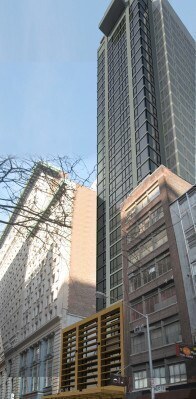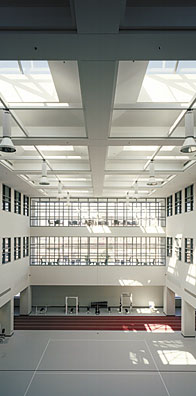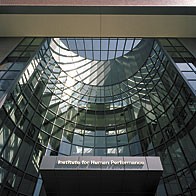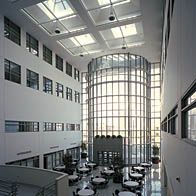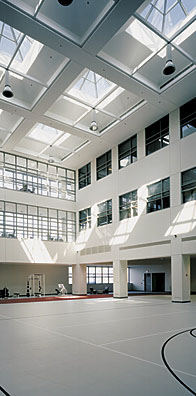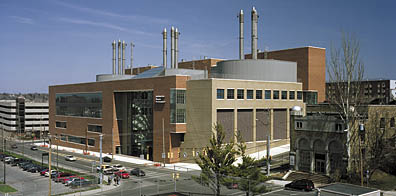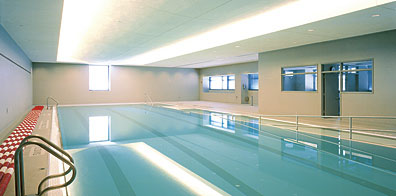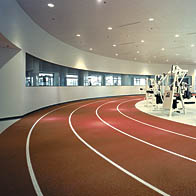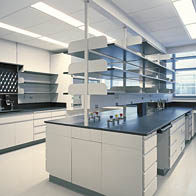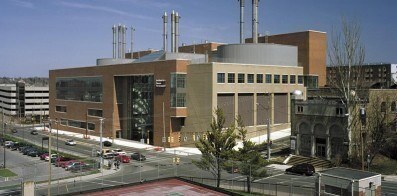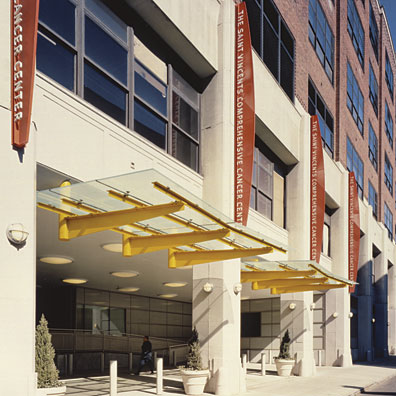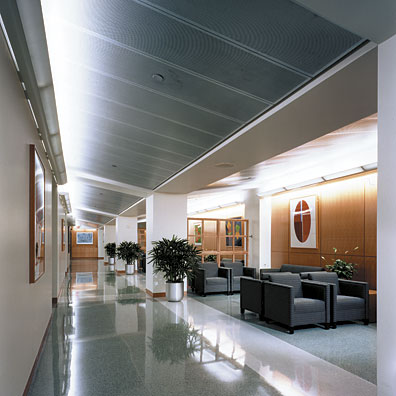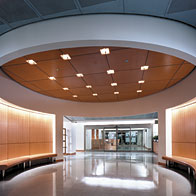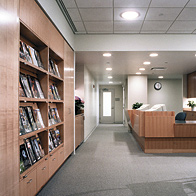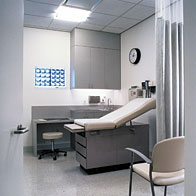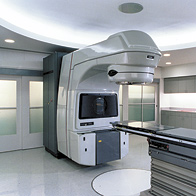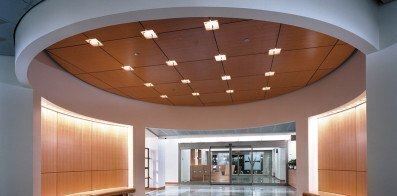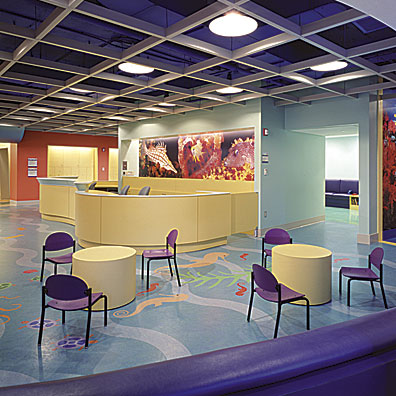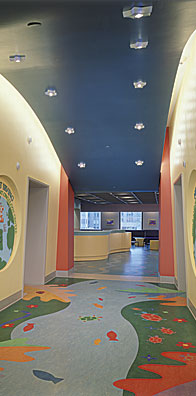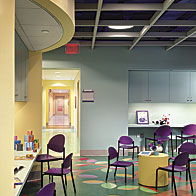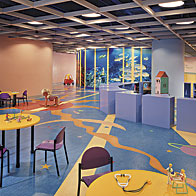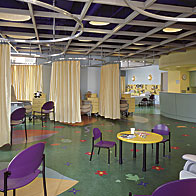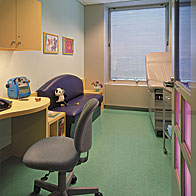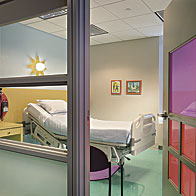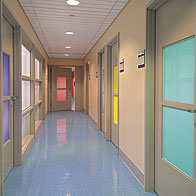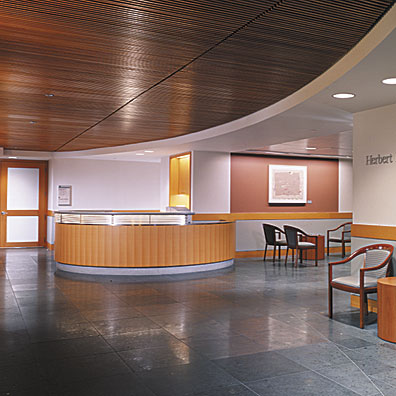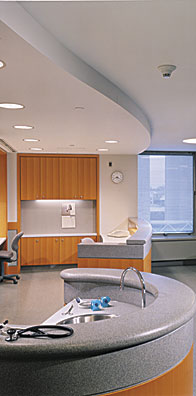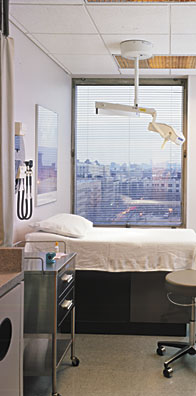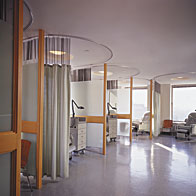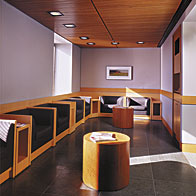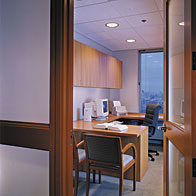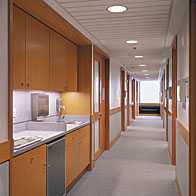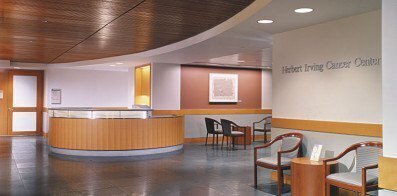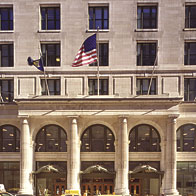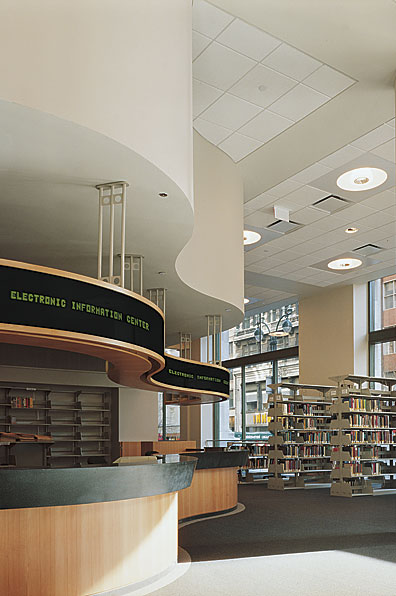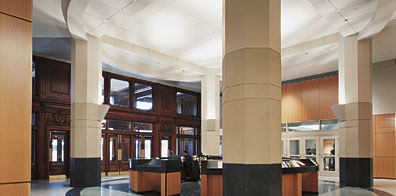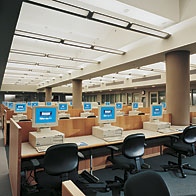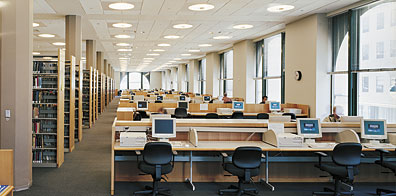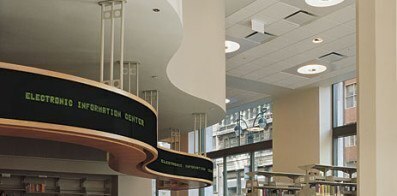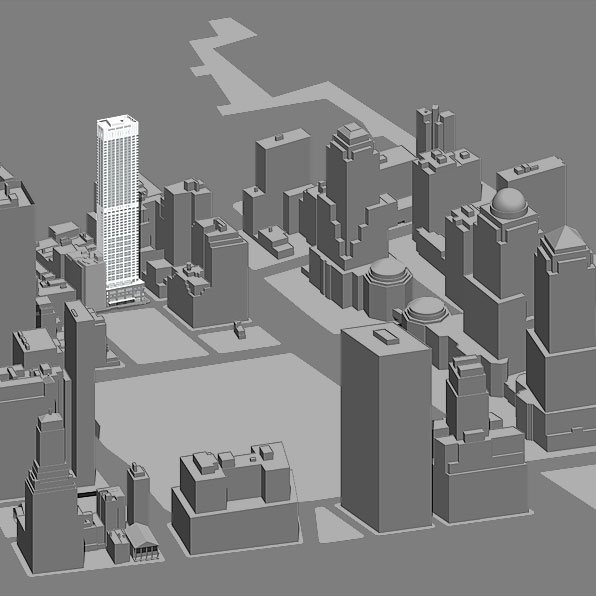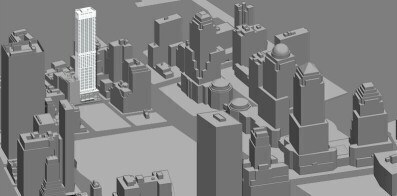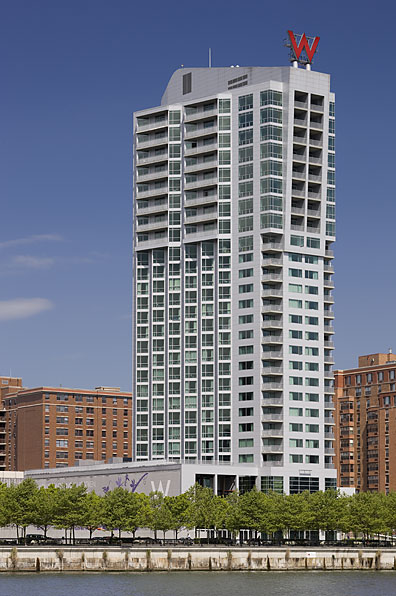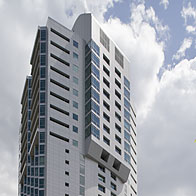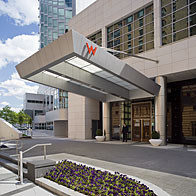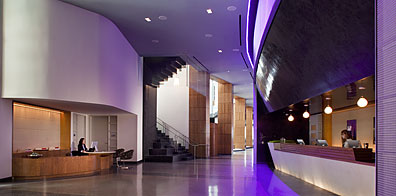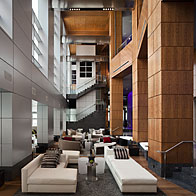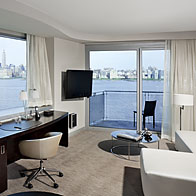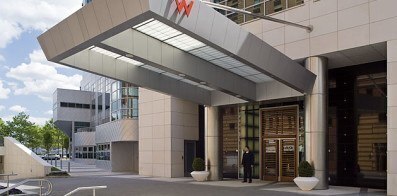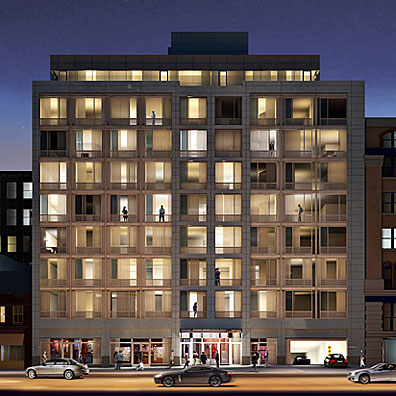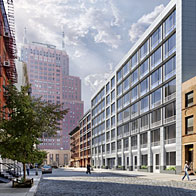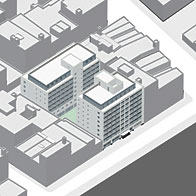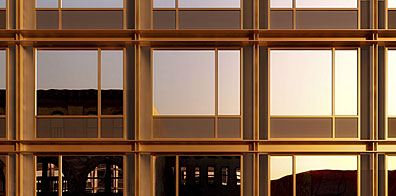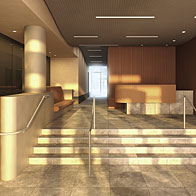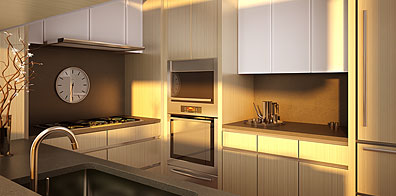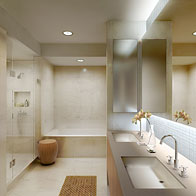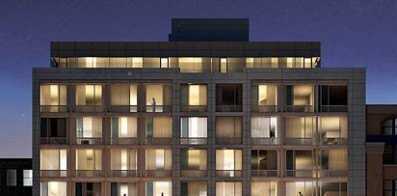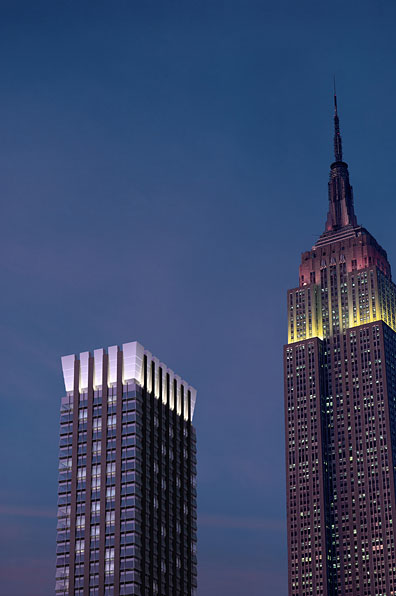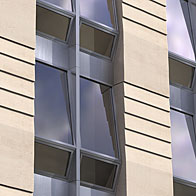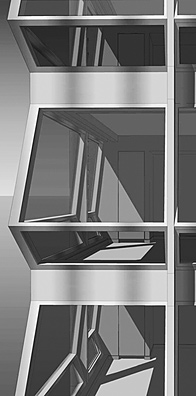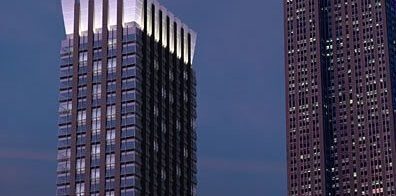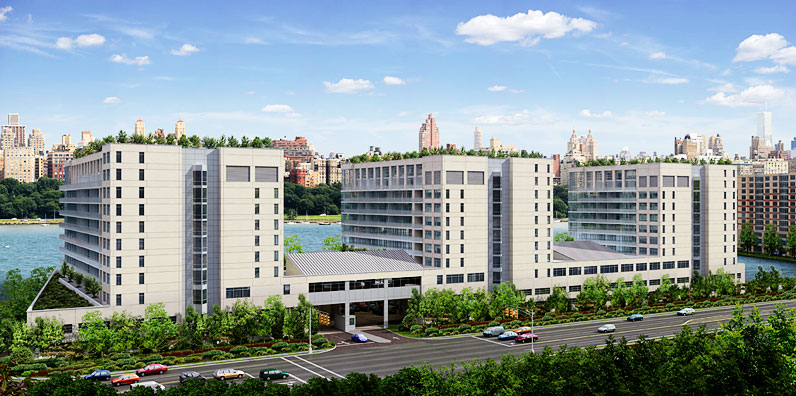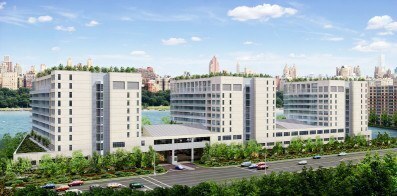State University of New York at Syracuse
Institute for Human Performance, Rehabilitation and Biomedical Research Syracuse, NY This facility for education research and patient care is a four-story structure accommodating a 19,000 square-foot gymnasium, a 75 foot long medical research swimming pool, a full-service orthopedic treatment center and 100 state of the art flexible lab modules. The building is divided into three parallel laboratory wings joined by two skylighted atriums. Continue BackThe design evolved from precise and extensive technical criteria and provides climate controlled spaces for multiple medical and recreational functions. Public and private domains are expressed and separated through the manipulation of natural light and by solid/void relationships.
David G. Murray, M.D., Distinguished Professor and Chairman, Department of Orthopedic Surgery
Saint Vincent’s Comprehensive Cancer Center
New York, NY The Saint Vincent’s Comprehensive Cancer Center involved the consolidation, expansion and enhancement of all of the hospital's existing outpatient cancer diagnostic and treatment services into approximately 65,000 square feet of renovated space. It is located on the ground floor of 111 Eighth Avenue, a 17-story, reinforced concrete commercial loft building from the 1930's with two levels of below grade parking. Continue BackPatient access is on West 15th Street under a covered vehicle drop-off. Patients who drive to the Center are provided with valet-type parking services. Ambulet and ambulance access for patients arriving by gurnies is provided at two locations on West 16th Street.
New York Presbyterian Hospital
Pediatric Oncology Center New York, NY The Pediatric Oncology Center, part of the five floor Herbert Irving Comprehensive Cancer Center, is a 15,000-square-foot outpatient exam and treatment facility for children ranging in age from infancy to eighteen years. Continue BackThe environment is conceived in the image of a child’s world, conveyed upon arrival in the elevator lobby by its softly waving pale blue ceiling dotted with star-shaped lights of white glass. The ceiling flows into the large main space that extends from one end of the floor to the other. It encompasses waiting and activity areas for all age groups and unifies these with exam, treatment and other patient support areas.
An expansive, loft-like feeling is enhanced by the open grid ceiling and the continuous linoleum floor design, with motifs based on natural elements, that flow into the group chemotherapy area. The main space is further defined by a colorful full height curvilinear wall on one side, and the “Thick Wall” (with patient lockers and toy storage) at the other, that serve as landmarks throughout the floor.
Painted wood doors with colored and translucent glass lead to patient areas off of the main space, including Exam Rooms. There a comfortable setting is created with lounge-like banquette seating and playful shapes for colorful desk and sink cabinets.
Within the open area and adjacent to group treatment and Exam Rooms, a long curvilinear banquette defines the Quiet Activity Area. In the North Open Area, Child Life specialists guide group arts and crafts and water play. A separate area for Toddlers is enclosed by a low divider formed from oversized “blocks”. Teenagers can find a more independent haven in the semi-circular, den-like Adolescent Lounge.
Parents especially requested two support spaces. The Family Lounge, which overlooks the Hudson River, provides a place for enjoying typical family meals. The Parents’ Lounge is a “kid-free” zone where adults can privately take an emotional break, research their child’s illness, converse with other parents, or work.
New York Presbyterian Hospital
Medical/Surgical Oncology Center New York, NY The Medical/Surgical Oncology Center is a 30,000-square-foot treatment facility that occupies two floors of the five-floor Herbert Irving Comprehensive Cancer Center. Continue BackThe clearly organized plan, natural materials and colors provide a supportive environment for patients, visitors and staff. Patients enter through a light-filled elevator lobby, finished with glass wall panels, stone flooring and a vaulted wood ceiling, and are received in an open waiting area with oriented views to the outdoors. Warm beech wood used for the vault continues in the reception desk, paneled walls, accessible slat ceiling, banquette seating trim and throughout the facility. All are complemented by a soft green limestone floor.
An arc shape in the ceiling, mirrored in the floor pattern and desk design, directs toward smaller waiting areas to the north and south, where the same material palette and banquette seating reoccur. These sub-waiting areas are centrally located between groups of exam rooms and consultation rooms, arranged for convenient way-finding. Translucent glass in doors and sidelights transmit light and minimize the apparent length of interior hallways.
The open group and semi-private chemotherapy areas take advantage of views, including one of the Hudson River, and are organized to minimize visual clutter and maximize staff efficiency. Supply, waste and staff prep areas are nearby but out of patients’ sight. Curved ceiling tracks define patient areas, each lighted by a translucent glass fixture mounted in a domed recess, creating a comfortable, diffuse light. Task lighting is provided by the adjustable lamp attached to mobile storage taboret next to each patient.
The pharmacy and laboratory are centrally located to serve the entire five-floor center via dumbwaiter access.
The City University of New York
The Graduate Center, Mina S. Rees Library New York, NY The new Graduate Center is a vertical complex organized on twelve levels of the former B. Altman's Department Store in midtown Manhattan. The challenges of the 580,000-square-foot renovation included not only the updating of a nearly 100-year-old building, but the design of a wide variety of educational and cultural facilities including the new library, which is at the intellectual heart of the campus. Continue BackThe library also offers group study areas, miscellaneous special collection rooms, dissertation archives and a media library complete with music listening stations. In its previous quarters, the library was in the basement. Now library users have the luxury of sitting next to 12-foot-high windows that look out onto Fifth Avenue, Madison Avenue, and 35th Street.
The facility’s high-tech capabilities are announced at the library reference desks with LED signage strips running along the edge of the desk canopies. Flexibility is key throughout the facility, typified by the workstations’ adjustable perforated dividers, which provide lateral flexibility, create a discrete territory and are handicapped accessible. Cabling in the walls and floor are easily accessible for upgrades. Sight lines extend down the length of the library, allowing easy supervision by library staff.
One special part of the library design was the reclaiming of select historic interior elements. The most visible result was the restoration and replication of one of the original stairs and elevators as the main circulation between the library’s three floors.
Opposite the entrance to the library is the cultural complex that includes three theaters, an art gallery, a bookstore, a coffee bar, and television production facilities. Academic and research areas, located on the middle five floors, include classrooms, lecture halls, computer labs, faculty and student offices and study areas. The top floors house administrative offices, a skylit conference room and a conference center, organized around the central dining commons.
W New York – Downtown
Hotel and Residential Condominiums New York, NY The W New York-Downtown Hotel & Residences is a 57-story tower rising at the southern edge of New York City’s World Trade Center Memorial Site, one block from the planned Freedom Tower, at 123 Washington Street. The first luxury hotel and residential tower to be built in Lower Manhattan, it is also the first new project not part of the WTC complex to begin construction since 9/11. Continue BackThe glass-clad tower contains 217 hotel rooms and 222 residences that have commanding views of the memorial site and the city as well as water views to the east, west and south. It sits on a four-story, limestone and glass podium that offers a full service restaurant and lounge, conference center, fitness center and hotel administrative space. The adjacent lobbies for the hotel and residences have elevators that take hotel guests to the fifth floor sky lobby and bring residents to the condominium portion. Beginning on the 32nd floor, the condominiums range from studios to one- and two-bedroom units. A terrace on the building’s roof is available to residents.
The tower’s glass curtain wall has a subtle grid pattern of white, grey and clear glass panels that visually separates it from more commercial structures. The grid is expressed in white glass panels with variations in the pattern differentiating the three sections of the tower: the hotel guest rooms, the hotel residences and the condominiums. The white panels feature two layers of glass with the outer layer receiving a pattern of white dots over an interior panel also painted white. The shadows of the dots against each white panel will move as the sun passes, adding a depth of tone and texture. A grid of grey spandrel glass appears to pass behind the white panels, with the actual windows expressed as regular vision glass.
Responding to zoning incentives, the project offers a landscaped urban plaza that introduces more open space downtown. The paved portion will offer tables and chairs with service from the hotel’s ground floor café. The slightly elevated portion of the plaza will have a floor of wood slats and a small grove of trees with seating underneath.
Associate Architect: Avinash K. Malhotra Architects.
W Hoboken
Hotel and Residential Condominiums Hoboken, NJ The W Hoboken is a 27-story hotel and residential tower containing 225 hotel rooms, 40 residences, retail and event spaces and a basement parking garage. Located on the west shore of the Hudson River in downtown Hoboken, New Jersey, the metal and glass tower establishes a counterpoint to the existing mid-rise, masonry structures that characterize the Hoboken shoreline. Continue BackRising from the base, a wedge shaped tower maximizes views eastward to Manhattan by virtue of its inflected geometry. The hotel rooms, developed to the standard of the W brand, form the 14-story mid-section of the new tower, the height of which relates to the cornice line of the adjacent properties. The north and south facades of the mid-section of the tower are characterized by abstract fluting formed by full height bay windows included within the typical hotel rooms to further enhance the view. Nine floors of hotel residences form the top of the tower, creating a cornice by virtue of the exterior balconies. Rising above the neighboring structures, the new residences offer unobstructed views north and south.
Click here to be directed to the W Hotel and Residences website for more information and a virtual tour (a new tab or window will open).
Soho Mews – 311 West Broadway
Retail & Residences New York, NY Soho Mews, at 311 West Broadway, is a residential condominium in New York City’s Soho Cast Iron Historic District. The two-building project consists of a nine-story structure facing West Broadway and an eight-story one facing Wooster Street, with a shared courtyard mews between them. The 175,000-square-foot project offers 5,000 square feet of commercial space, 68 luxury apartments and underground parking. Continue Back. The metal and glass facade recalls the evolution of these materials in the Soho Cast Iron Historic District. Three different types of glass are used—clear, frosted and fritted – to give a sense of layered depth to the facade. The buildings’ massing relates to the specific scale of West Broadway and Wooster Street and maintains the continuity of the street wall.
New York City Landmarks
Preservation Commission
February 15, 2005
Langham Place, Fifth Avenue
Hotel and Residences New York, NY The Langham Place is a new, 600 foot tall, 57-story five star hotel and residential tower containing 157 hotel rooms, 57 hotel apartments and 190 private residences. The site is located on Fifth Avenue, two blocks north of the Empire State Building and is set amidst three designated historic landmark structures. Continue BackThe ten story limestone podium, capped by a carved, reductive cornice, reinforces the spatial definition of the street while its tri-partite vertical layering and rhythmic masonry piers establish a scale and proportion sympathetic to the neighboring historic buildings. Borrowing a compositional device from McKim Mead & White’s Tiffany Building near by, an arcade-like four story ‘giant order’ of piers forms a gracious base at the street level with grand storefront windows befitting Fifth Avenue. Windows, marquees and abstract cornices of matte finish stainless steel counterpoint the warm hue of the stone.
The tower, set back from the street and rising from the 10th floor, is comprised of a series of serriform precast concrete piers between which are deeply recessed windows. Specially developed vertically faceted window assemblies accentuate views from the tower to the street animating the facade and creating a unique profile as they wrap the corners of the building at the residential levels.
Capping the tower is an inverted crown of textured stainless steel panels which conceal the mechanical penthouses. Illuminated at night by concealed up-lights the crown engages in and reinforces a longstanding tradition of iconic tops on New York City skyscrapers.
Riverview Condominiums
North Bergen, NJ The Riverview Residential Development is comprised of three nine-story luxury condominium towers sitting on a landscape plinth on top of a two-story parking structure. Located on New Jersey’s Hudson River Gold Coast on one of the last remaining vacant sites on River Road, the 6 acre complex takes full advantage of the unobstructed views of the Manhattan skyline. Continue BackExterior materials include metal panel and stucco with punch widows on River Road, to create a more solid street facade. The residential tower ‘fingers’ extend out towards the River with floor to ceiling glass. The roof structures above the amenity spaces are articulated in shaped standing metal roofing, expressing their interior volumes.
